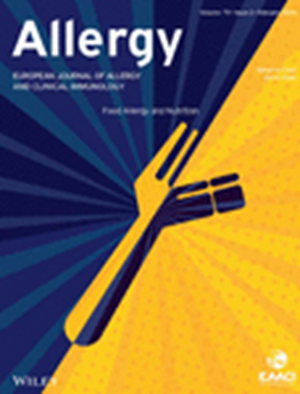治疗花生过敏的皮肤免疫疗法
IF 12.6
1区 医学
Q1 ALLERGY
引用次数: 0
摘要
花生过敏的治疗方法仍然有限,但目前正在研究包括表皮免疫疗法(EPIT)在内的新方法。EPIT 利用皮肤免疫系统促进对食物过敏原的耐受性。Viaskin™ Peanut 是一种处于后期临床开发阶段的 EPIT 方法,它使用一种带有凝结室的闭塞贴片,使表皮自然失水,从而溶解贴片上的干燥抗原,然后被皮肤朗格汉斯细胞吸收和捕获。这种形式的 EPIT 无需破坏皮肤屏障,因此可以通过靶向非血管化表皮和限制全身过敏原暴露来避免促炎细胞因子反应。广泛的临床前研究表明,Viaskin Peanut 具有独特的脱敏机制,包括在独特的调节性 T 细胞群体的驱动下改变疾病的潜力。对 Viaskin Peanut 进行的大量临床研究表明,该药具有脱敏作用,并能降低反应的严重程度,尤其是在 1-11 岁的儿童中,而且安全性良好,大部分皮肤反应为轻度至中度,并能随着时间的推移而减轻。使用 Viaskin Peanut 的 EPIT 可能是一种治疗花生过敏的潜在方法,它在临床上切实可行,并具有长期疗效和耐受性。本文章由计算机程序翻译,如有差异,请以英文原文为准。
Epicutaneous immunotherapy for the treatment of peanut allergy
Peanut allergy treatment options remain limited, but novel approaches are being studied, including epicutaneous immunotherapy (EPIT). EPIT uses the cutaneous immune system to promote tolerance to food allergens. Viaskin™ Peanut, an approach to EPIT in late‐stage clinical development uses an occlusive patch with a condensation chamber that enables natural epidermal water loss to solubilize dry antigen on the patch, which is then absorbed and captured by skin Langerhans cells. This form of EPIT does not require disruption of the skin barrier, thus avoiding a proinflammatory cytokine response by targeting the nonvascularized epidermis and limiting systemic allergen exposure. Extensive preclinical research suggests that Viaskin Peanut has a distinct mechanism of desensitization, including the potential for disease modification, driven by a unique population of regulatory T cells. Numerous clinical studies of Viaskin Peanut have demonstrated desensitization and reductions in reaction severity, particularly in children aged 1 through 11 years, as well as a favorable safety profile with mostly mild‐to‐moderate skin reactions that were observed to decrease over time. EPIT with Viaskin Peanut may be a potential therapeutic option for peanut allergy that is clinically practical with long‐term efficacy and tolerability.
求助全文
通过发布文献求助,成功后即可免费获取论文全文。
去求助
来源期刊

Allergy
医学-过敏
CiteScore
26.10
自引率
9.70%
发文量
393
审稿时长
2 months
期刊介绍:
Allergy is an international and multidisciplinary journal that aims to advance, impact, and communicate all aspects of the discipline of Allergy/Immunology. It publishes original articles, reviews, position papers, guidelines, editorials, news and commentaries, letters to the editors, and correspondences. The journal accepts articles based on their scientific merit and quality.
Allergy seeks to maintain contact between basic and clinical Allergy/Immunology and encourages contributions from contributors and readers from all countries. In addition to its publication, Allergy also provides abstracting and indexing information. Some of the databases that include Allergy abstracts are Abstracts on Hygiene & Communicable Disease, Academic Search Alumni Edition, AgBiotech News & Information, AGRICOLA Database, Biological Abstracts, PubMed Dietary Supplement Subset, and Global Health, among others.
 求助内容:
求助内容: 应助结果提醒方式:
应助结果提醒方式:


